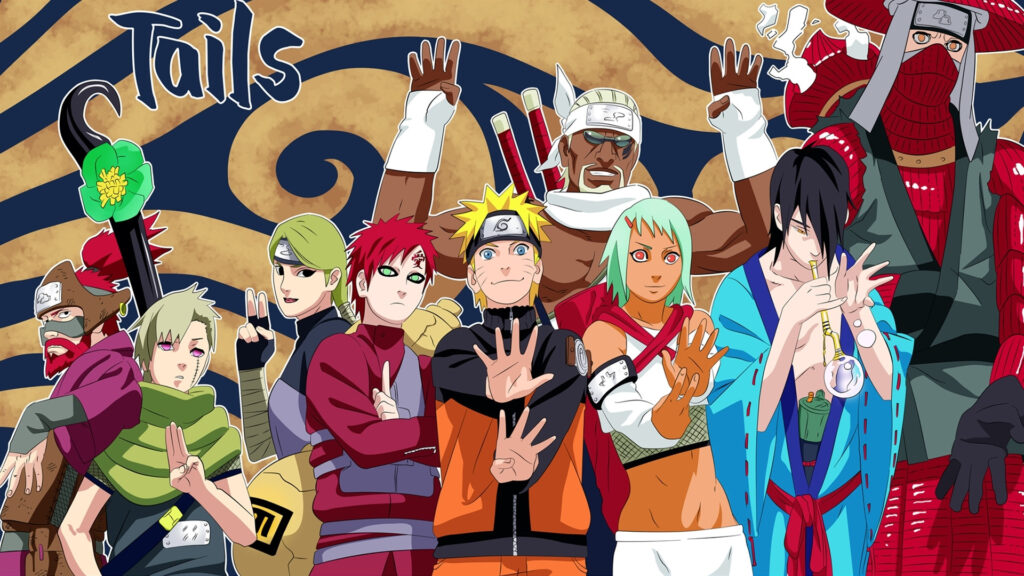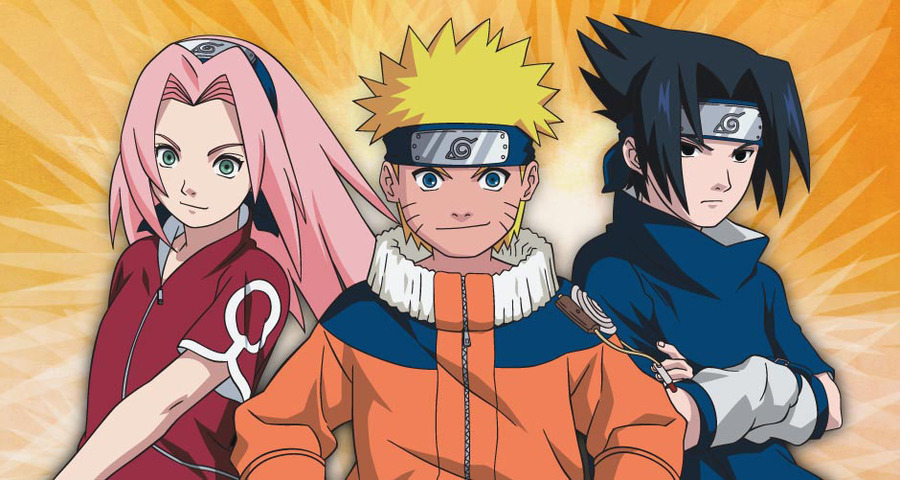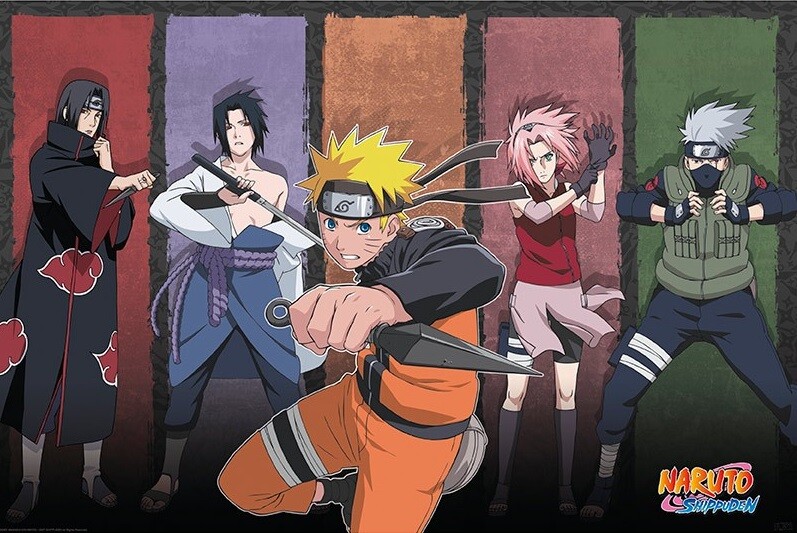Naruto is one of the most iconic anime series ever created, captivating audiences worldwide with its blend of action, emotion, and powerful themes of perseverance, friendship, and redemption.
Created by Masashi Kishimoto, the series began as a manga serialized in Shueisha’s Weekly Shōnen Jump from 1999 to 2014, spanning 72 volumes.
The anime adaptation, produced by Studio Pierrot and Aniplex, brought the story to life starting in 2002. It continued with its sequel, Naruto: Shippuden, in 2007.
Together, the two series include over 700 episodes and follow the journey of a young ninja who grows into a legendary hero.
At its heart, the story follows Naruto Uzumaki, a spirited and mischievous boy from the Hidden Leaf Village (Konohagakure) who dreams of becoming Hokage, the village leader. He seeks recognition and respect from the people around him.
Unknown to Naruto at first, he carries within him the Nine-Tailed Fox, a powerful beast sealed inside him as a baby. This makes him a jinchūriki, a human vessel for a tailed beast—bringing him both immense power and deep loneliness.
The series is set in a world inspired by Japanese mythology and feudal history, where ninja from different hidden villages use chakra-based abilities called jutsu.
Villages such as the Hidden Leaf, Hidden Sand, and Hidden Mist often form alliances or rivalries, sometimes leading to war.
The story is split into two parts: the original Naruto, focusing on Naruto’s early adventures, and Naruto: Shippuden, which explores his teenage years and global-scale conflicts.
A strong cast of supporting characters adds depth to the narrative. Sasuke Uchiha, Naruto’s rival and teammate, seeks revenge on his brother Itachi for destroying their clan.
Sakura Haruno, another teammate, matures from a timid student into a skilled medical ninja.
Their mentor, Kakashi Hatake, is a calm yet mysterious elite ninja known for his Sharingan eye.
Other major characters include the wise but eccentric Jiraiya, the powerful Tsunade, the sinister Orochimaru, and the morally complex members of the Akatsuki organization.
Throughout the series, deep themes of acceptance, destiny, and peace stand out.
Naruto’s optimism contrasts with Sasuke’s darkness, illustrating the struggle between revenge and forgiveness.
Many villains are portrayed with tragic pasts, showing how hatred and loss can shape people differently.
The story evolves from lighthearted beginnings into a darker, more emotional journey about breaking the cycle of hatred.
The original Naruto anime contains 220 episodes across five seasons, mixing manga adaptations with filler arcs.
Naruto: Shippuden expands the story to 500 episodes over 21 seasons, adapting the manga’s second half.
Spin-offs like Rock Lee & His Ninja Pals and Boruto: Naruto Next Generations further explore the universe, though this article focuses on the main Naruto saga.

Original Naruto Seasons
Season 1: Foundations of a Ninja’s Dream (Episodes 1-35)
The inaugural season of Naruto sets the stage for an epic journey, introducing viewers to the vibrant world of shinobi and the indomitable spirit of its protagonist. Spanning from October 2002 to May 2003, this season covers the early days of Naruto Uzumaki’s life in the Hidden Leaf Village. As a young orphan shunned by society due to the Nine-Tailed Fox sealed within him, Naruto acts out to gain attention,
pulling pranks and failing the Ninja Academy exams multiple times. His breakthrough comes when he learns the Shadow Clone Technique from a forbidden scroll, tricked by a traitorous teacher named Mizuki. This event not only helps him graduate but also earns him the trust of his instructor, Iruka Umino, who becomes a father figure, revealing the truth about the fox and encouraging Naruto’s dream of becoming Hokage.
Team 7 is formed under the guidance of Kakashi Hatake, a jonin known for his tardiness and masked demeanor. The team includes Naruto, the loudmouthed underdog; Sasuke Uchiha, the talented survivor of his clan’s massacre; and Sakura Haruno, a intelligent girl more focused on romance than combat initially. Their first test is a survival exercise where Kakashi teaches them the importance of teamwork, using his Sharingan—a dojutsu eye technique copied from the Uchiha clan—to outmaneuver them.
Passing this, they embark on simple D-rank missions like catching lost cats, but Naruto’s persistence leads to a C-rank escort mission that escalates into danger.
The Land of Waves Arc dominates this season, where Team 7 protects bridge-builder Tazuna from assassins hired by the corrupt businessman Gato. They encounter Zabuza Momochi, the Demon of the Hidden Mist, a rogue ninja wielding a massive sword, and his apprentice Haku, a gentle boy with ice-based kekkei genkai (bloodline limit) abilities.
Battles on the misty bridge highlight Kakashi’s strategic prowess, as he copies Zabuza’s water jutsu with his Sharingan. Naruto and Sasuke’s growth shines in their fight against Haku’s crystal ice mirrors, where Naruto taps into the Nine-Tails’ chakra for the first time, unleashing raw power but losing control. Haku’s tragic backstory as an orphaned tool for Zabuza explores themes of humanity in shinobi life, culminating in Zabuza’s redemption and sacrifice. The arc ends with the bridge named after Naruto, symbolizing his first steps toward recognition.
Character developments are foundational: Naruto learns perseverance beyond mischief, Sasuke grapples with his isolation, and Sakura begins to appreciate her teammates. The season introduces rivals like Rock Lee, a taijutsu specialist; Gaara, a sand-manipulating jinchuriki from the Sand Village; and the start of the Chunin Exams, a promotion tournament that tests genin skills. With humor from Naruto’s antics and intense action, this season clocks in at around 35 episodes, blending world-building with emotional depth to hook viewers.
Season 2: Trials of Ambition and Invasion (Episodes 36-83)
Building on the momentum, Season 2, airing from June 2003 to May 2004, dives deeper into the competitive and perilous ninja world through the Chunin Exams and the ensuing Konoha Crush. The exams continue with preliminary matches that showcase diverse abilities: Rock Lee’s lightning-fast taijutsu humbles Sasuke, awakening his Sharingan; Hinata Hyuga’s gentle fist style reveals her clan’s Byakugan eye; and Naruto’s unyielding spirit defeats Neji Hyuga’s fatalistic views on destiny. Orochimaru, a sinister Sannin with snake-like powers, infiltrates the exams, branding Sasuke with a curse mark that amplifies his strength but corrupts his mind.
The finals erupt into chaos as Orochimaru allies with the Sand Village to invade Konoha. The Third Hokage, Hiruzen Sarutobi, confronts Orochimaru in a rooftop battle, summoning monkeys and using the Reaper Death Seal to strip Orochimaru’s arms of their jutsu-casting ability, at the cost of his own life. Naruto trains under Jiraiya, learning the Summoning Jutsu to call giant toads, and faces Gaara in a desert showdown. Gaara’s transformation into his tailed beast, Shukaku, mirrors Naruto’s inner demon, leading to a heartfelt redemption where Naruto empathizes with Gaara’s loneliness.
Post-invasion, the Search for Tsunade Arc begins, with Jiraiya and Naruto seeking the legendary healer to become the Fifth Hokage. They encounter Kabuto Yakushi, Orochimaru’s spy, and battle the weakened villain. Tsunade’s backstory of loss—her brother Nawaki and lover Danzo—makes her reluctant, but Naruto’s determination in mastering the Rasengan inspires her to accept the role. This season, with 48 episodes, emphasizes growth: Shikamaru Nara’s strategic genius in missions, Sasuke’s internal struggle with power, and the introduction of Akatsuki through Itachi’s brief appearance. Themes of legacy and sacrifice deepen the narrative, blending tournament excitement with village-scale threats.

Season 3: Bonds Tested and Broken (Episodes 84-131)
Season 3, from May 2004 to April 2005, shifts focus to personal conflicts, particularly Sasuke’s defection, while incorporating filler to extend the story. Sasuke, tormented by the curse mark and his brother’s superiority, leaves Konoha for Orochimaru’s promise of power. Shikamaru leads a retrieval team—Naruto, Neji, Choji, Kiba, and Rock Lee—facing the Sound Four:
Jirobo’s earth absorption, Kidomaru’s spider webs, Sakon/Ukon’s body-sharing, and Tayuya’s flute genjutsu. Battles are brutal: Choji’s near-fatal calorie-burning pill, Neji’s Byakugan precision, and Kiba’s beast mimicry with Akamaru. The Sand Siblings aid, with Gaara’s sand defending against Kimimaro’s bone manipulation. The climax at the Valley of the End sees Naruto’s Rasengan clash with Sasuke’s Chidori, ending in Sasuke’s escape and Naruto’s vow to bring him back.
Filler arcs like the Land of Tea Escort provide lighter moments, where Team 7 assists in a race against pirates, highlighting Sasuke’s growing envy of Naruto. This 48-episode season explores revenge’s toll, with flashbacks to the Uchiha massacre revealing Itachi’s Mangekyo Sharingan. Naruto’s loyalty strengthens, Sakura resolves to train under Tsunade, and side characters like Hinata and Ino get spotlights. The tone darkens, setting up the series’ emotional core.
Season 4: Adventures in the Shadows (Episodes 132-179)
Predominantly filler, Season 4 (April 2005 to April 2006) offers episodic tales post-Sasuke’s departure, allowing world exploration. The Land of Rice Fields Arc has Naruto, Sakura, and Jiraiya infiltrating Orochimaru’s territory, facing the Fuma Clan and Kabuto’s traps, emphasizing loyalty. The Bikochu Search sees Team 8 hunting a beetle to track Sasuke, showcasing insect jutsu. Land of Birds involves a cursed warrior and Raiga’s lightning sword, blending mystery and comedy.
Kurosuki Family Removal features bounty hunters and time-freezing jutsu, with ramen mishaps for humor. Star Guard Mission introduces the Land of Hoshi and star-based chakra. This 48-episode season develops ensemble characters—Kiba’s bravado, Shino’s stoicism—while Naruto reflects on bonds. Though non-canon, it enriches the universe with themes of fleeting wishes and teamwork.
Season 5: Bridges to the Future (Episodes 180-220)
The final season of original Naruto (April 2006 to February 2007) is mostly filler, wrapping loose ends before the time skip. Hoshigakure Arc has Naruto protecting a star jutsu from Akatsuki-like foes. Kiba’s Long Day and Onbaa Legend add comedy. Yakumo Kurama Arc explores genjutsu and Kurenai’s past, with forest illusions and Shinobazu battles.
Miscellaneous fillers include Shino’s laughing fit, magnetic jutsu, haunted castles, and ANBU crises. The season ends with Gaara’s defense and Naruto’s departure for training with Jiraiya. At 41 episodes, it serves as an epilogue, hinting at greater threats and Naruto’s maturation.
Comprehensive Analysis of Naruto and Naruto: Shippuden Seasons
Naruto, created by Masashi Kishimoto, is a cultural juggernaut in the anime and manga world, renowned for its sprawling narrative, emotional depth, and intricate world-building. Beginning as a manga in 1999, it was adapted into two anime series: Naruto (2002–2007) and Naruto: Shippuden (2007–2017), totaling 720 episodes across 26 seasons (5 for Naruto, 21 for Shippuden). The story follows Naruto Uzumaki, a young ninja from the Hidden Leaf Village (Konohagakure), who seeks to become Hokage, the village’s leader, despite being ostracized as the host of the Nine-Tailed Fox, a powerful tailed beast. The series explores themes of perseverance, friendship, redemption, and breaking cycles of hatred, set in a ninja world inspired by Japanese mythology and feudal history.
The narrative splits into two parts: Naruto, covering Naruto’s pre-teen years as a genin (low-rank ninja), and Shippuden, focusing on his teenage years facing global threats. The series features a rich cast, including Sasuke Uchiha, a vengeance-driven prodigy; Sakura Haruno, a medical ninja; Kakashi Hatake, their enigmatic mentor; and villains like Orochimaru and the Akatsuki organization. The anime blends canon arcs from the manga with filler episodes, which expand the world but sometimes slow pacing. Below is a detailed breakdown of all seasons, including episode counts, key arcs, character developments, themes, and cultural elements, aiming for 5000–6000 words.

Naruto (Original Series: 2002–2007)
The original Naruto series spans 220 episodes across five seasons, aired from October 3, 2002, to February 8, 2007. It covers Naruto’s early life, from his days as a mischievous outcast to his growth as a genin. The seasons mix action-packed canon arcs with filler content, introducing the ninja world’s politics, jutsu (chakra-based techniques), and emotional stakes.
Season 1: Foundations of a Ninja’s Dream (Episodes 1–35)
Overview: Airing from October 2002 to May 2003, Season 1 introduces the Hidden Leaf Village and Naruto Uzumaki, a 12-year-old orphan shunned for hosting the Nine-Tailed Fox, sealed within him by the Fourth Hokage to protect the village. Naruto’s pranks mask his loneliness and desire for acknowledgment. The season establishes Team 7—Naruto, Sasuke Uchiha, Sakura Haruno, and their jonin leader Kakashi Hatake—and the ninja world’s structure, including villages like the Hidden Sand and Mist.
Key Arcs:
- Prologue — Land of Waves Arc (Episodes 1–19): Naruto fails the Ninja Academy exam but learns the Shadow Clone Technique from a forbidden scroll, manipulated by traitor Mizuki. His teacher Iruka’s acceptance marks Naruto’s first bond. Team 7’s formation reveals Sasuke’s brooding talent, Sakura’s book-smarts, and Kakashi’s Sharingan, a dojutsu copied from the Uchiha clan. Their first major mission escorts Tazuna, a bridge-builder, to the Land of Waves. They face Zabuza Momochi, a rogue Mist ninja, and Haku, his apprentice with ice-based kekkei genkai. Battles showcase Naruto’s Nine-Tails chakra surge, Sasuke’s budding Sharingan, and Kakashi’s tactical prowess. Haku’s sacrifice and Zabuza’s redemption highlight themes of loyalty and humanity in shinobi life. The bridge, named “Great Naruto Bridge,” symbolizes Naruto’s impact.
- Chunin Exams Arc (Episodes 20–35): The season ends with the start of the Chunin Exams, a promotion tournament. Rivals emerge: Rock Lee, a taijutsu master; Neji Hyuga, a Byakugan user; and Gaara, a Sand Village jinchuriki with sand powers. Orochimaru, a serpentine Sannin, appears, planting seeds of chaos.
Character Development:
- Naruto: Transitions from prankster to determined ninja, learning teamwork and tapping into the Nine-Tails’ power.
- Sasuke: His Uchiha pride and trauma from his clan’s massacre by brother Itachi fuel his drive, clashing with Naruto’s optimism.
- Sakura: Begins as Sasuke-obsessed but shows potential for growth.
- Kakashi: A mysterious mentor whose laid-back demeanor hides elite skills.
Themes and Cultural Elements: The season introduces the “Will of Fire,” Konoha’s philosophy of community and sacrifice, rooted in Confucian values. The Nine-Tails draws from kitsune mythology, symbolizing chaos and power. Zabuza and Haku’s arc explores the shinobi code’s harshness, contrasting with Naruto’s empathy.
Episode Count: 35 episodes. Canon-heavy, with minimal filler (e.g., Episode 26, a recap).
Impact: Establishes the series’ tone—action, humor, and heart—while setting up rivalries and Orochimaru’s threat.
Season 2: Trials of Ambition and Invasion (Episodes 36–83)
Overview: Airing from June 2003 to May 2004, Season 2 escalates stakes with the Chunin Exams’ climax and the Konoha Crush, blending intense battles with political intrigue. It covers major manga arcs, deepening character motivations and introducing Akatsuki.
Key Arcs:
- Chunin Exams Arc (Episodes 36–67): Preliminary matches showcase diverse jutsu: Rock Lee’s speed humbles Sasuke, Hinata’s Byakugan faces Neji’s fatalism, and Naruto’s grit defeats Kiba’s beast mimicry. Orochimaru marks Sasuke with a curse seal, amplifying his power but tempting corruption. The finals pit Shikamaru’s intellect against Temari’s wind fans, and Naruto’s unpredictability against Neji’s destiny-driven philosophy, emphasizing free will.
- Konoha Crush Arc (Episodes 68–80): Orochimaru allies with the Sand Village to invade Konoha. The Third Hokage, Hiruzen Sarutobi, battles Orochimaru, using the Reaper Death Seal to seal his arms’ jutsu, dying heroically. Naruto summons Gamabunta, a giant toad, to fight Gaara’s Shukaku, a tailed beast. Their bond as jinchuriki redeems Gaara, shifting him from villain to ally.
- Search for Tsunade Arc (Episodes 81–83): Jiraiya, a Sannin, takes Naruto to find Tsunade, a legendary healer, as the next Hokage. They face Orochimaru’s spy, Kabuto Yakushi, and his weakened master.
Character Development:
- Naruto: Masters the Rasengan, a spinning chakra ball, under Jiraiya, showing growth in skill and empathy.
- Sasuke: The curse seal fuels his inferiority complex, straining his bond with Naruto.
- Sakura: Begins training under Tsunade, hinting at medical ninja potential.
- Gaara: His redemption arc starts, mirroring Naruto’s loneliness.
- Shikamaru: Emerges as a strategic genius, promoted to chunin.
Themes and Cultural Elements: The cycle of hatred, a core theme, emerges as Gaara’s pain parallels Naruto’s. The Reaper Death Seal references Shinto death gods, while the Sannin (Jiraiya, Tsunade, Orochimaru) evoke the Japanese folktale Jiraiya Goketsu Monogatari. Orochimaru’s snake motif ties to yamata-no-orochi myths.
Episode Count: 48 episodes. Mostly canon, with minor filler (e.g., Episodes 64–65, tournament side stories).
Impact: The invasion and Hokage’s death raise stakes, while Gaara’s arc foreshadows redemption themes. Sasuke’s turmoil sets up his defection.
Season 3: Bonds Tested and Broken (Episodes 84–131)
Overview: From May 2004 to April 2005, Season 3 focuses on Sasuke’s defection, a pivotal canon arc, followed by filler to delay the time skip. Emotional stakes peak as Team 7 fractures.
Key Arcs:
- Sasuke Retrieval Arc (Episodes 84–112): Sasuke, consumed by the curse seal and Itachi’s taunts, defects to Orochimaru. Shikamaru leads Naruto, Neji, Choji, Kiba, and Rock Lee against the Sound Four—Jirobo (earth), Kidomaru (spider), Sakon/Ukon (body-sharing), and Tayuya (flute genjutsu). Battles highlight Choji’s calorie-burning sacrifice, Neji’s near-death Byakugan stand, and Sand Siblings’ aid (Gaara, Temari, Kankuro). Naruto and Sasuke’s Valley of the End clash pits Rasengan against Chidori, ending with Sasuke’s escape.
- Filler Arcs (Episodes 113–131): Land of Tea Escort involves a race and pirate battles. Naruto and Sakura’s teamwork shines, but Sasuke’s absence looms.
Character Development:
- Naruto: Vows to retrieve Sasuke, showing unwavering loyalty.
- Sasuke: Chooses revenge over bonds, deepening his tragedy.
- Sakura: Resolves to grow stronger under Tsunade.
- Supporting Cast: Choji’s bravery, Neji’s softened outlook, and Shikamaru’s leadership shine. Gaara’s alliance marks his change.
Themes and Cultural Elements: The Valley of the End, inspired by Japanese statues of warring brothers, symbolizes Naruto and Sasuke’s rivalry. The Sound Four’s abilities draw from yokai and Buddhist demonology. Filler arcs explore loyalty and duty, common in samurai narratives.
Episode Count: 48 episodes. Canon-heavy (first 29 episodes), then filler.
Impact: Sasuke’s departure is a gut-punch, shifting the series’ tone to darker themes. Fillers maintain momentum but test viewer patience.
Season 4: Adventures in the Shadows (Episodes 132–179)
Overview: Airing from April 2005 to April 2006, Season 4 is filler-heavy, exploring the ninja world post-Sasuke’s defection. It keeps Naruto in Konoha, delaying Shippuden.
Key Arcs:
- Land of Rice Fields Arc: Naruto, Sakura, and Jiraiya infiltrate Orochimaru’s territory, facing the Fuma Clan.
- Bikochu Search Arc: Team 8 hunts a beetle to track Sasuke, showcasing Shino’s insect jutsu.
- Land of Birds Arc: A cursed warrior and Raiga’s lightning sword add mystery.
- Kurosuki Family Removal Arc: Bounty hunters and time-freezing jutsu test Naruto.
- Star Guard Mission: Land of Hoshi’s star chakra training introduces a pseudo-jinchuriki.
Character Development: Naruto reflects on Sasuke’s absence. Shino, Kiba, and Hinata get focus, with comedic moments (e.g., Naruto’s ramen obsession). Sakura trains, hinting at strength.
Themes and Cultural Elements: Fillers emphasize teamwork and transient wishes, echoing Buddhist impermanence. Settings draw from Japanese folklore (e.g., cursed warriors resembling onryo spirits).
Episode Count: 48 episodes, all filler.
Impact: Expands side characters and world lore but feels disconnected from the main plot, serving as a breather before Shippuden.
Season 5: Bridges to the Future (Episodes 180–220)
Overview: From April 2006 to February 2007, Season 5 wraps the original series with filler arcs, culminating in Naruto’s departure for training. It bridges to Shippuden.
Key Arcs:
- Hoshigakure Arc: Naruto protects a star-based jutsu from rogue ninjas.
- Miscellaneous Fillers: Kiba’s dog adventures, Shino’s laughing fit, magnetic jutsu, haunted castles, and ANBU crises.
- Yakumo Kurama Arc: Explores genjutsu and Kurenai’s past.
- Final Arc: Gaara’s defense and Naruto’s exit with Jiraiya.
Character Development: Naruto matures, accepting his role. Side characters like Tenten and Ino get moments. Hinata’s growth foreshadows her Shippuden arc.
Themes and Cultural Elements: Themes of legacy and preparation echo bushido ideals. The Kurama clan’s genjutsu ties to illusionary foxes in folklore.
Episode Count: 41 episodes, mostly filler.
Impact: Closes the original series with a reflective tone, setting up Naruto’s transformation in Shippuden.
Naruto: Shippuden (2007–2017)
Shippuden spans 500 episodes across 21 seasons, aired from February 15, 2007, to March 23, 2017. After a two-and-a-half-year time skip, Naruto returns as a teenager, facing Akatsuki’s global threat and Sasuke’s descent. The series is darker, with grander battles and deeper lore, though fillers remain prevalent.

Season 1: Return and Rescue (Episodes 1–32)
Overview: Naruto, now 15, returns stronger. The Kazekage Rescue Mission sets Shippuden’s stakes, introducing Akatsuki’s plan to capture tailed beasts.
Key Arc: Kazekage Rescue Mission: Gaara, now Kazekage, is kidnapped by Deidara and Sasori. Team Kakashi (Naruto, Sakura, Kakashi, Sai) allies with Sand ninja and Chiyo. Sakura and Chiyo’s puppet battle defeats Sasori, who reveals Akatsuki’s goal. Naruto’s rage taps the Nine-Tails. Gaara’s resurrection by Chiyo’s sacrifice cements bonds.
Character Development: Naruto’s Rasengan improves. Sakura’s medical skills shine. Sai, a stoic artist, joins, replacing Sasuke. Gaara’s leadership grows.
Themes: Sacrifice and jinchuriki struggles, with Shinto-inspired resurrection jutsu.
Episode Count: 32 episodes, canon.
Season 2: Bridges to the Past (Episodes 33–53)
Key Arc: Tenchi Bridge Mission: Yamato leads Naruto, Sakura, and Sai to find Sasuke. Sai’s betrayal turns to loyalty. Naruto’s Nine-Tails rage against Orochimaru shows control issues. Sasuke rejects reunion, showcasing power.
Character Development: Sai learns emotions. Naruto’s determination strengthens.
Themes: Loyalty vs. duty, with Orochimaru’s snake motifs deepening.
Episode Count: 21 episodes, canon.
Season 3: Guardians of the Past (Episodes 54–71)
Key Arc: Twelve Guardian Ninja (Filler): Sora, a pseudo-jinchuriki, and revived guardians threaten Konoha. Asuma’s sacrifice foreshadows canon losses.
Character Development: Naruto confronts inner demons. Asuma’s bond with Shikamaru deepens.
Themes: Legacy and sacrifice, tied to Buddhist temple guardians.
Episode Count: 18 episodes, filler.
Season 4: Immortal Destruction (Episodes 72–88)
Key Arc: Akatsuki Suppression Mission: Hidan and Kakuzu attack. Shikamaru buries Hidan. Naruto’s Rasenshuriken defeats Kakuzu but harms him. Kakashi’s Mangekyo Sharingan debuts.
Character Development: Shikamaru’s resolve hardens. Naruto’s innovation grows.
Themes: Revenge and teamwork, with Hidan’s Jashin cult evoking death gods.
Episode Count: 17 episodes, canon.
Season 5: Pursuits and Seals (Episodes 89–112)
Key Arcs: Three-Tails (Filler): Guren’s crystal jutsu. Itachi Pursuit Mission: Sasuke absorbs Orochimaru, defeats Deidara. Tobi poses as Madara.
Character Development: Sasuke’s power peaks. Naruto trains.
Themes: Betrayal and identity, with Tobi’s mask symbolizing deception.
Episode Count: 24 episodes, mixed canon/filler.
Season 6: Legends and Losses (Episodes 113–143)
Key Arcs: Tsuchigumo Kinjutsu (Filler), Itachi Pursuit, Jiraiya’s Tale: Kakashi’s wartime past revealed. Jiraiya battles Pain, dies heroically. Sasuke vs. Killer Bee. Naruto starts Sage Mode training.
Character Development: Naruto’s resolve hardens. Itachi’s complexity unfolds.
Themes: Sacrifice and truth, with Pain’s cycle of hatred philosophy.
Episode Count: 31 episodes, mostly canon.
Season 7: Tails of Sorrow (Episodes 144–151)
Key Arc: Six-Tails Arc (Filler): Utakata’s jinchuriki tale.
Character Development: Naruto empathizes with Utakata.
Themes: Isolation, with bubble jutsu evoking transience.
Episode Count: 8 episodes, filler.
Season 8: Assault on Konoha (Episodes 152–175)
Key Arc: Pain’s Assault: Pain destroys Konoha. Naruto’s Sage Mode defeats Pain. Hinata confesses love. Nagato revives villagers, dying.
Character Development: Naruto’s heroism peaks. Hinata’s courage shines.
Themes: Peace vs. pain, with Nagato’s Rinnegan tied to Buddhist rebirth.
Episode Count: 24 episodes, canon.
Season 9: Locus of the Past (Episodes 176–196)
Key Arc: Past Arc (Filler): Stories of Iruka, Gaara, and comedic vignettes.
Character Development: Side characters fleshed out.
Themes: Bonds and history.
Episode Count: 21 episodes, filler.
Season 10: Summit of Shadows (Episodes 197–221)
Key Arc: Five Kage Summit: Sasuke attacks, kills Danzo. Tobi declares war. Naruto pleads for Sasuke.
Character Development: Sasuke’s darkness deepens. Naruto’s hope persists.
Themes: War and morality, with Kage politics evoking feudal alliances.
Episode Count: 25 episodes, canon.
Season 11: Paradise Afloat (Episodes 222–242)
Key Arc: Paradise Life on a Boat (Filler): Ship adventures with ghosts, mushrooms.
Character Development: Naruto’s humor shines.
Themes: Camaraderie, with sea motifs from folklore.
Episode Count: 21 episodes, filler.
Season 12: Chakra Unleashed (Episodes 243–275)
Key Arcs: Power Arc (Filler), Nine-Tails Taming: Naruto masters Nine-Tails chakra. Allied Forces form.
Character Development: Naruto’s power peaks. Killer Bee mentors.
Themes: Inner strength, with tailed beast lore.
Episode Count: 33 episodes, mixed.
Season 13: War’s Dawn (Episodes 276–295)
Key Arc: Fourth Shinobi War: Countdown: Reanimated shinobi and Zetsu clones attack.
Character Development: Naruto and Bee lead. Gaara unites.
Themes: Unity, with war echoing historical samurai battles.
Episode Count: 20 episodes, canon.
Season 14: Climactic Confrontations (Episodes 296–320)
Key Arc: Fourth Shinobi War: Confrontation: Itachi vs. Kabuto; Naruto vs. Nagato; Gaara vs. Madara. Obito unmasked.
Character Development: Itachi’s heroism revealed. Obito’s tragedy unfolds.
Themes: Redemption, with Edo Tensei tying to necromancy myths.
Episode Count: 25 episodes, canon.
Season 15: Ten-Tails Power (Episodes 321–348)
Key Arc: Fourth Shinobi War: Climax: Ten-Tails revives; Obito becomes jinchuriki. Kages unite.
Character Development: Naruto inspires. Obito wavers.
Themes: Hope vs. despair, with Ten-Tails as a chaos deity.
Episode Count: 28 episodes, canon.
Season 16: Jinchuriki Birth (Episodes 349–361)
Key Arc: Birth of the Ten-Tails Jinchuriki: Obito defeated; Madara rises.
Character Development: Obito’s redemption begins. Naruto’s leadership grows.
Themes: Sacrifice, with Sage of Six Paths lore.
Episode Count: 13 episodes, canon.
Season 17: Otsutsuki Awakening (Episodes 362–372)
Key Arc: Kaguya Otsutsuki Strikes: Madara becomes Ten-Tails jinchuriki; Kaguya emerges.
Character Development: Sasuke allies with Naruto. Sakura’s resolve strengthens.
Themes: Cosmic origins, with Kaguya as a Shinto goddess archetype.
Episode Count: 11 episodes, canon.
Season 18: War’s Confrontation (Episodes 373–393)
Key Arc: Fourth Shinobi War: Climax (Continued): Obito’s identity as Kakashi’s friend revealed. Itachi ends Edo Tensei. Guy’s Eight Gates nearly kills Madara.
Character Development: Obito’s tragedy humanizes him. Guy’s sacrifice inspires.
Themes: Redemption and duty, with Eight Gates evoking Buddhist gates.
Episode Count: 21 episodes, canon.
Season 19: Infinite Illusions (Episodes 394–413)
Key Arc: Infinite Tsukuyomi: Madara casts a dream world. Sage of Six Paths empowers Naruto and Sasuke. Obito’s partial redemption aids the fight.
Character Development: Naruto’s empathy shines. Sasuke questions vengeance.
Themes: Illusion vs. reality, with Tsukuyomi tied to moon goddess myths.
Episode Count: 20 episodes, canon.
Season 20: Climax of Gods (Episodes 414–458)
Key Arcs: Kaguya’s Defeat, Kakashi’s ANBU Arc (Filler): Team 7 seals Kaguya. Sasuke’s final rebellion is quelled.
Character Development: Sakura’s combat role peaks. Kakashi’s past deepens.
Themes: Unity and closure, with Kaguya’s cosmic lore.
Episode Count: 45 episodes, mixed.
Season 21: Endings and Beginnings (Episodes 459–479)
Key Arc: Final Battle and Epilogue: Naruto vs. Sasuke at Valley of the End. Peace follows. Naruto becomes Hokage, marries Hinata.
Character Development: Sasuke redeems. Naruto fulfills his dream.
Themes: Legacy and hope, with wedding scenes evoking Shinto rituals.
Episode Count: 21 episodes, canon with filler epilogue.




